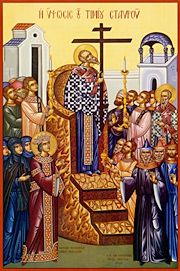Elevation of the Holy Cross
The Elevation of the Holy Cross is one of the Great Feasts of the Orthodox Church, celebrated on September 14. This feast is also referred to as the Exaltation of the Cross. This is also a popular name day for Stavroula/Stavros (from "stavros" meaning cross).
This feast commemorates two events:
- The finding of the Cross by the Empress Helen (the mother of St. Constantine the Great) on Golgotha, the place where Christ was crucified. When the true Cross was identified, it was lifted on high for all the people to see, who then continually sang Kyrie eleison, a practice which is still enacted at current celebrations of this feast.
- The recovery of the Cross on which Jesus Christ was crucified from the Persians. The Persians had captured it as a prize of war in Jerusalem, and it was recovered by the forces of the Eastern Roman Empire ("Byzantine Empire"). The cross was joyously held up for veneration by the Christian faithful upon its recovery.
This is one of the two feast days which is held as a strict fast. The other is the commemoration of the Beheading of John the Forerunner on August 29.
Celebration of the feast
This is a holy day of fasting and repentance. On this day the faithful make dedication to the crucified Lord and pledge their faithfulness to him by making prostrations at the Lords feet on the life creating Cross. For the feast, the Cross is placed on a tray surrounded by flowers or branches of basil, and placed in the center of the Church for veneration.
On the eve of the feast, Vespers is served and contains three Old Testament readings. The first from Exodus 15:22-16:1, tells of the "tree" which made the bitter waters sweet, the symbol of the Tree of the Cross. The second reading is from Proverbs 3:11-18, reminds us that the Lord chastens and corrects those whom he loves and that Divine Wisdom is "a Tree of life to those who lay hold upon her and trust in her, as in the Lord". The third reading is from the Prophecy of Isaiah 60:11-16, it tells of the "city of the Lord" where both Jews and Gentiles will live together and shall prostrate at the place of God's feet and "shall know that I, the Lord, am your Savior and your Redeemer, the mighty One of Jacob"
Sometimes Matins is served on the morning of the feast. The four directions of the universe are blessed with the Cross, while the faithful repeat the chant "Lord have mercy." The Matins Gospel reading is from John 12:28-36. In it Christ says that when he is elevated on the Cross he will draw all men to himself.
Divine Liturgy is served on the day on the feast. The normal antiphons are replaced by special verses from the psalms 22, 74, and 99, which have direct reference to Christ's crucifixion on the Cross. TheTrisagion is replaced by the hymn:
- Before Thy Cross we bow down in worship, O Master, and Thy holy Resurrection we glorify. (Thrice)
- Glory to the Father, and to the Son, and to the Holy Spirit, both now and ever, and unto the ages of ages. Amen.
- And Thy holy Resurrection we glorify.
- Before Thy Cross we bow down in worship, O Master, and Thy holy Resurrection we glorify.
As it is sung, the faithful prostrate. The epistle reading is from First Corinthians 1:18-24, and says that “the message of the cross is foolishness to those who are perishing, but to us who are being saved it is the power of God” The gospel reading is taken from John 19:6-11, 13-20, 25-28, and 30-35 together. This long reading is the passion account.
In Ethiopia
In the Ethiopian Orthodox Church, this feast (called Mesqel) is the most significant feast-day after Pascha and Christmas. The faithful light bonfires to commemorate St. Helen's bonfire that revealed the Holy Cross, and burn daisies to symbolize the incense that descended upon the location of the Cross.[1]
Hymns
- O Lord, save Thy people,
- And bless Thine inheritance.
- Grant victory to the Emperor [or "Thy people" or "the Orthodox Christians"]
- Over the barbarians, [or "their enemies"]
- And by the power of Thy Cross
- Preserve Thy commonwealth. [or "estate" or "habitation"]
Kontakion (Tone 4)
- As You were voluntarily raised upon the cross for our sake,
- Grant mercy to those who are called by Your Name, O Christ God;
- Make all Orthodox Christians glad by Your power,
- Granting them victories over their adversaries,
- By bestowing on them the Invincible trophy, Your weapon of Peace.
Instead of the Trisagion
- Before Thy Cross we bow down in worship, O Master, and Thy holy Resurrection we glorify. (Thrice)
- Glory to the Father, and to the Son, and to the Holy Spirit,
- both now and ever, and unto the ages of ages. Amen.
- And Thy holy Resurrection we glorify.
- Before Thy Cross we bow down in worship, O Master, and Thy holy Resurrection we glorify.
See also
External links
- The Universal Exaltation of the Precious and Life-Giving Cross - GOARCH web site
- The Universal Exaltation of the Precious and Life-Giving Cross - OCA web site
- Elevation of the Cross - The Orthodox Faith, by the V. Rev. Thomas Hopko
- Icons of the Elevation of the Cross
